36 Real-World Examples Of Gamification In eCommerce (Ones That Actually Drive Sales)


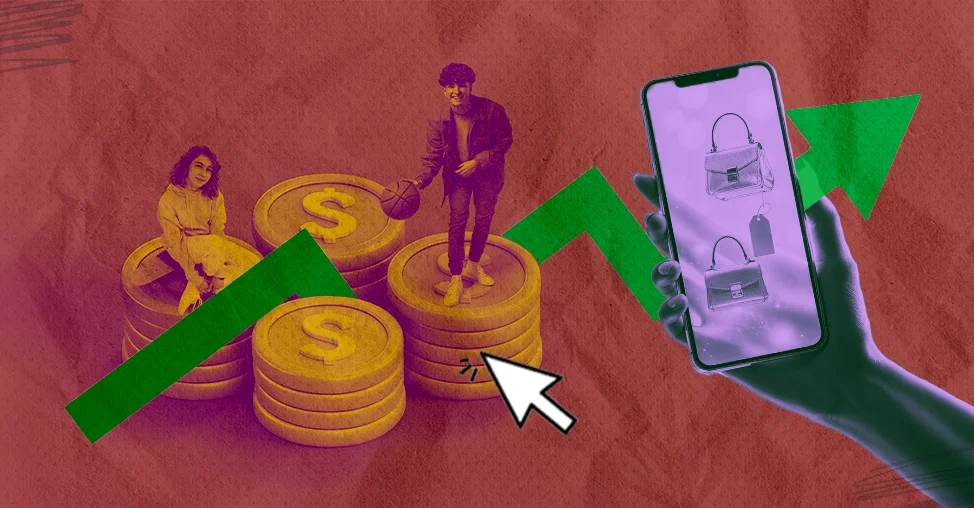
Remember Willy Wonka’s Golden Ticket? The perfect example of how gamification can send sales through the roof. 🙂
And it’s not fiction!
Research shows gamified retail keeps people hooked. About 62.5% of shoppers aged 16–30 admitted that game-like features actually make them buy more.
The catch, however? Most eCommerce brands go way overboard with it.
That’s why we’re walking you through 36 examples of gamification in eCommerce – ranging from the not-so-obvious examples to extremely easy-to-implement ones.
We’ll start with a few you definitely didn’t see coming, and end with the usual suspects:
1. SourceBMX gamifies bike shopping into bike building
2. Rumpl’s customization gamification feels personal
3. Liquid Death takes auction gamification to the next level
4. Charlotte Tilbury builds an immersive playground
5. Coach makes sustainability collectible with digital tokens
6. Rimmel London lets shoppers play to win
7. Exponent Skincare runs trials with challenge gamification
8. Morphe’s Augmented Reality (AR) gamification acts like a skincare genie
9. Uniqlo builds trust with size-finder gamification
10. Selkirk’s AI-powered live chat gamification leads to discovery
11. Lalo shapes brand decisions with vote gamification
12. Cult Beauty runs an innovative ‘donate to unlock’ gamification
13. Last Crumb makes bundle building feel like a game
14. E.L.F.’s loyalty program gamification keeps shoppers coming back
15. Nuun Hydration post-purchase gamification lets shoppers earn for runs
16. GNC nails spin the wheel gamification
17. REP Fitness uses an unusual progress bar gamification
18. Retrospec asks the right question with lead capture gamification
19. Gibbon USA solves doubt quickly with quiz gamification
20. Nomadix lets shoppers ‘play’ with the image
21. Oru Kayak surprises shoppers with gift gamification
22. Lowe’s runs the clock on ‘Deal of the day’ gamification
23. Dr. Barbara Sturm makes buying easier with ‘checkout gamification’
24. Ergatta teases with mystery gamification
25. Burrow gamifies product configurations
26. Quaker Chewy hides messages in their social media gamification
27. Hers runs a visual profile builder quiz gamification
28. Canvaspop asks to scroll with teaser email gamification
29. Crocs makes livestreams feel like real-time game shows
30. Pure Life turns giveaways into a treasure hunt
31. We are Knitters drops ‘Golden Tickets’
32. La Jolie Muse guarantees rewards with gift card gamification
33. Ulta Beauty gamifies winback for inactive shoppers
34. Astrid & Miyu run a seasonal gamification sequence
35. Five CBD makes referral gamification feel personal
36. Coogi Australia nails review/UGC gamification
But first…..
Gamification is just psychology with a sense of control (and rewards).
People love that feeling of progress: earning points, unlocking perks, or seeing their name climb a leaderboard. It’s not the prize alone, it’s also that sense of achievement that comes rushing.
Gamification in eCommerce revolves around two levers:
- intrinsic motivators (belonging, curiosity, self-improvement)
- extrinsic ones (rewards, discounts, access)
In many ways, it’s similar to what Accenture calls immersive retail, like letting shoppers:
- explore 3D product models
- build personalized makeup palettes
- join virtual fashion shows
The goal? Pull shoppers closer to the product without forcing the sale.
And it’s clearly working. A study found that gamified interactions strengthen both brand reputation and repurchase intent.
But what helps create a truly immersive gamified experience in eCommerce?
Here’s what drives it all:
Here are some great examples that achieve perfect harmony 👇
Why make shoppers explore 30 add-ons for one purchase when they can do the exact same thing, but in a game (instead of a list)?
Take SourceBMX’s bike builder, for example – it feels like a game; shoppers can add accessories, and truly make it their own (creating gamification-driven personalization):
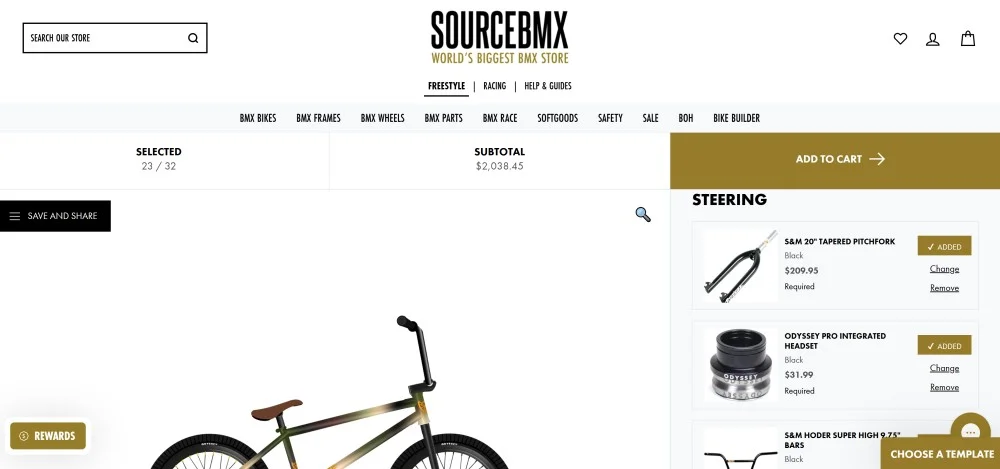
How you can apply this gamification idea on your eCommerce store:
Also read: 38 Brilliant Examples of eCommerce Personalization
If you don’t want a full-scale product builder, you can take a book out of Rumpl’s gamification example and let shoppers customize the product by adding their name or message.
Note how the interface looks like a form, with an AI-created visualization to show a real-time display of the customization:

How you can apply this gamification idea on your eCommerce store:
This gamification example takes a book out of eBay’s legendary bid system (the best possible form of gamification there is on eCommerce stores).
However, what sets this example apart is the exclusivity of the auction, because the product is just one of a kind (and by this, we mean, only one was ever produced). As a result, the winning bid after 810 bids was $68,200 (that’s what hype combined with gamification will do):
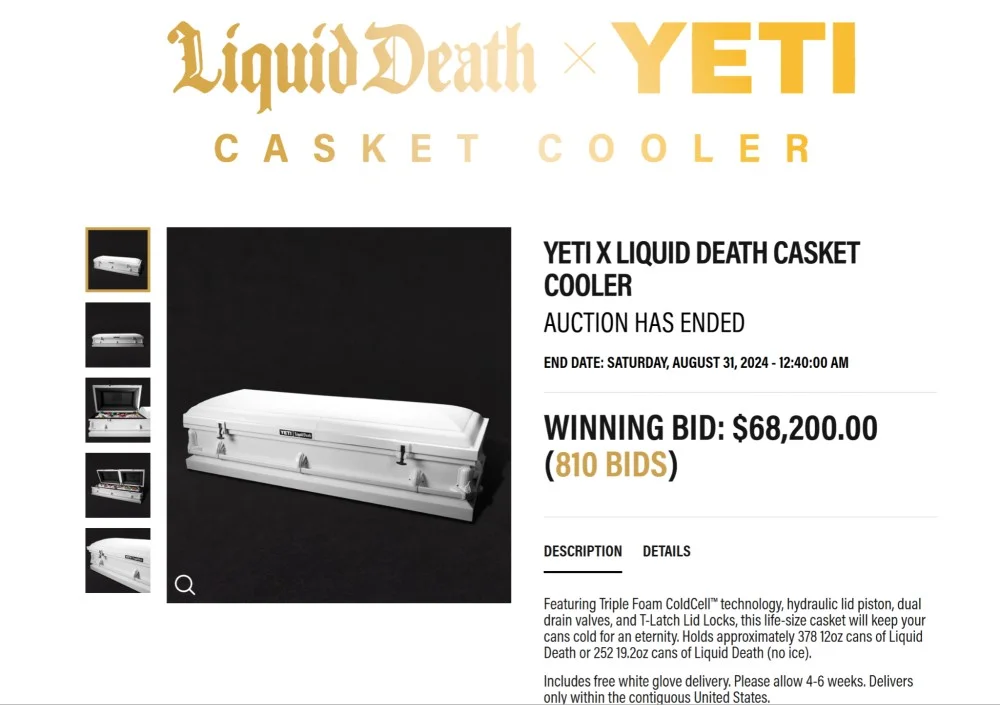
How you can apply this gamification idea on your eCommerce store:
Also read: Lessons From 6 Kickass Pre-Order Campaigns (eCommerce)
This gamification idea may be a bit hard to achieve, but it is an awesome way to keep shoppers engaged.
Charlotte Tilbury creates a virtual store to celebrate their custom collection in honor of 100 years of Disney. The USP here? Shoppers can not only engage with the virtual store to view products, but they can also invite friends and family as well and chat with digital avatars:
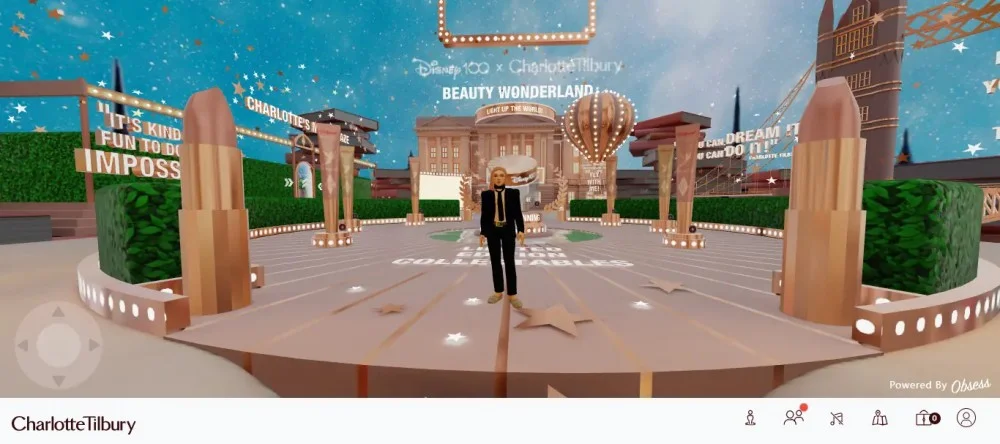
What to remember before applying this gamification idea:
We’ve all heard of cloud storage. But what if it could also hold your Coach handbag? 🙂
Coachtopia (Coach’s customer experience program) gamifies their sustainability initiatives and also makes shoppers feel confident of the value of their purchase, because they can literally see how one of a kind it is, within their cell phones:
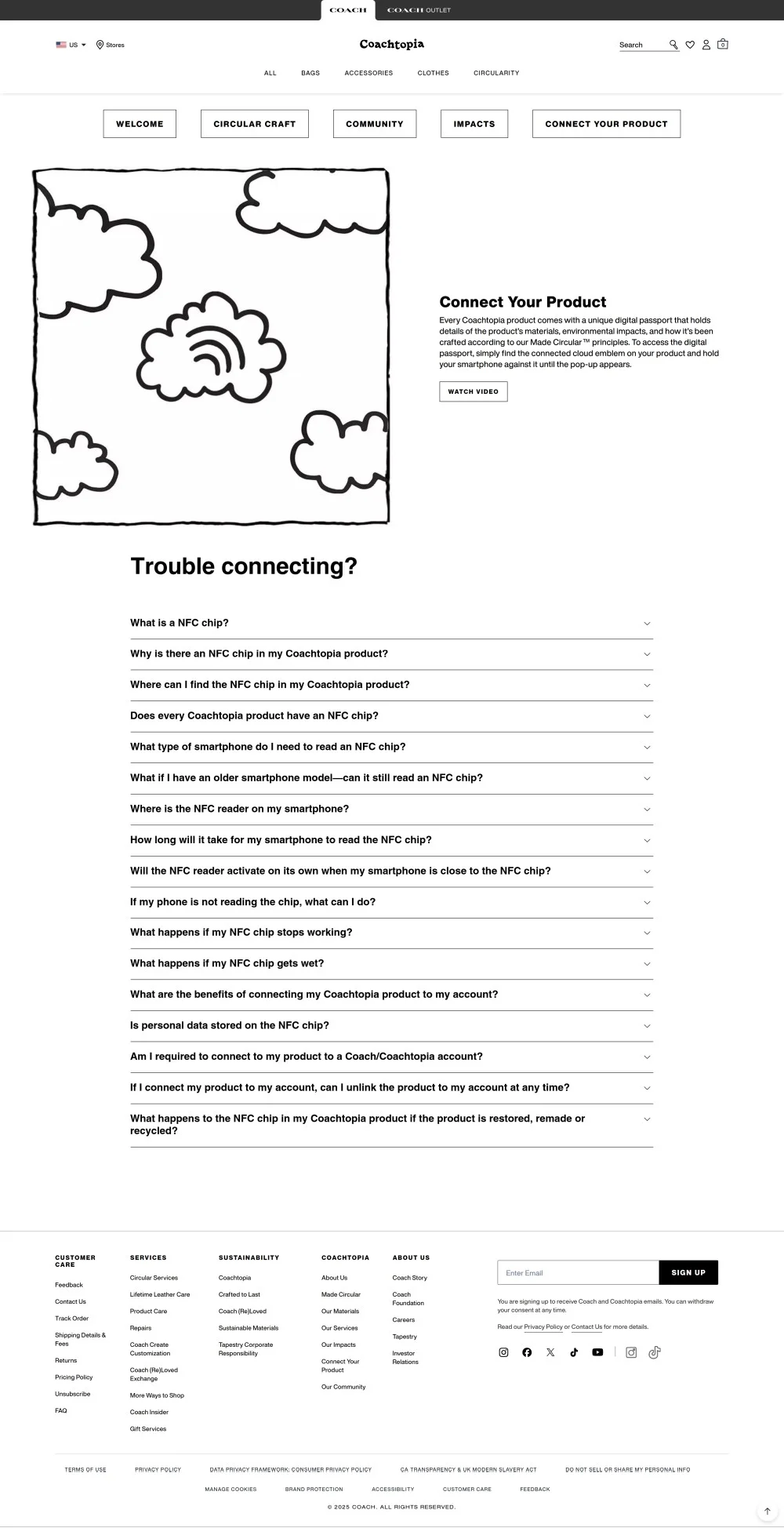
How you can apply this gamification idea on your eCommerce store:
Gamification starts with ‘game’ – Rimmel London lets shoppers spend some time catching makeup products.
Why: they’ve a limited-time daily contest for winning a bundle of products – all shoppers have to do is play a game:
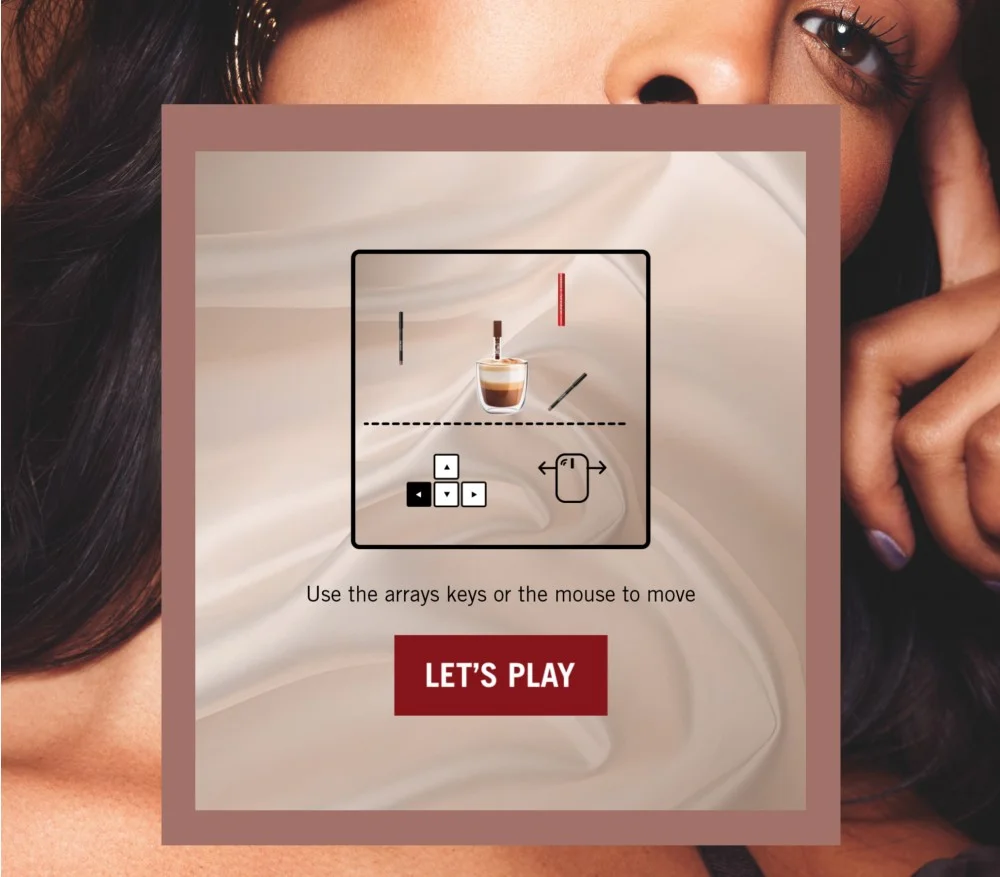
How you can apply this gamification idea on your eCommerce store:

Also read: 50 Proven Online Promotion Ideas For eCommerce
The reward of all challenges is mostly a ‘feel-good’ factor and social acceptance. However, the question remains: can you actually replicate this gamification technique on your eCommerce store, while getting shoppers to pay?
As it turns out, you can! Take this gamification example from Exponent Skincare – note how they frame a ‘try before you buy’ and ‘refund guarantee’ to create a ‘challenge’ environment:
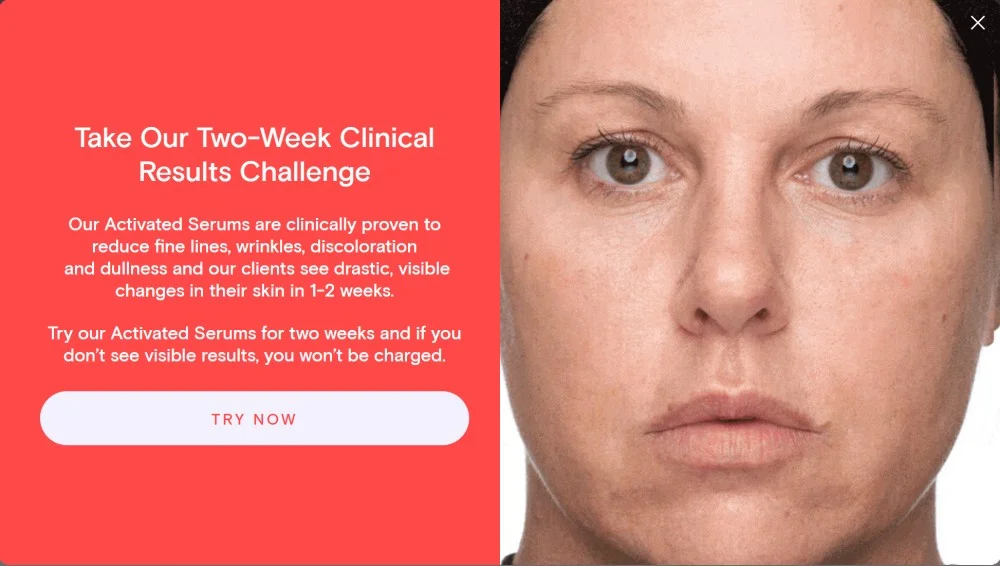
How you can apply this gamification idea on your eCommerce store:
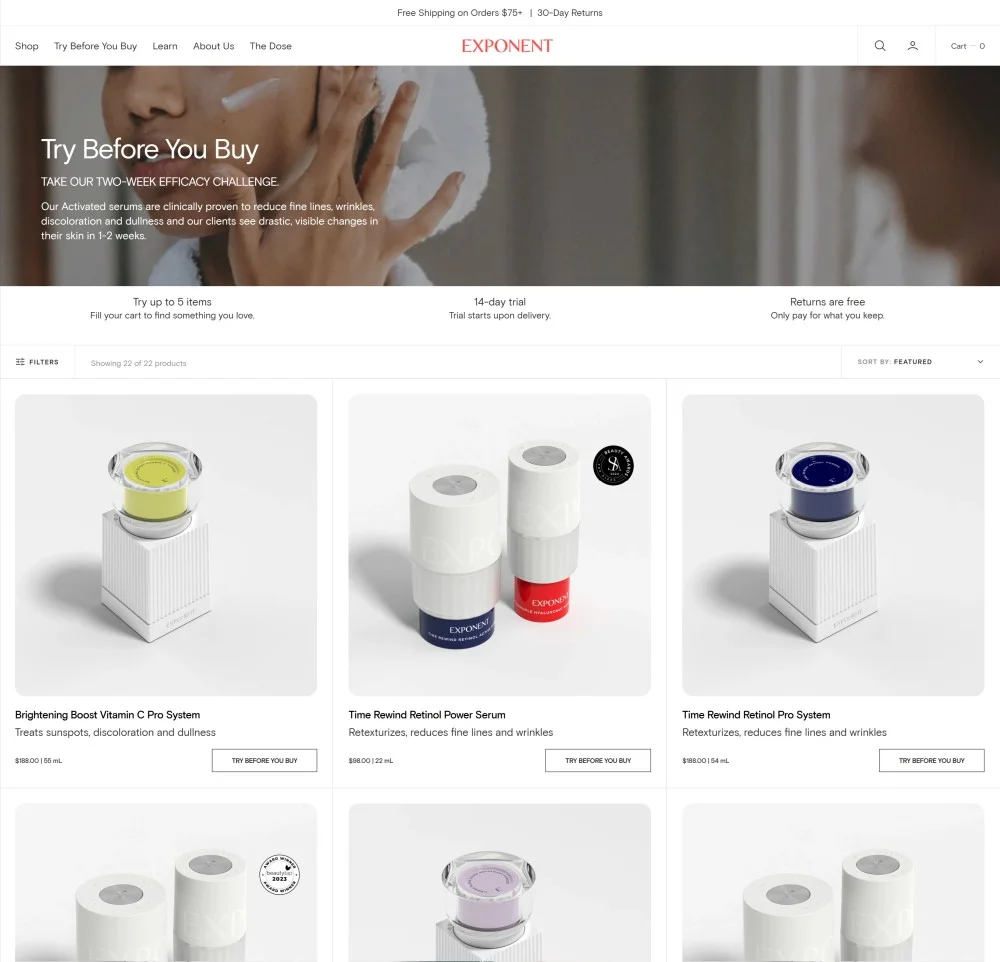
Also read: Preventing Buyer's Remorse: How eComm Stores Can Curb Post-Purchase Anxiety
Quizzes can take too much of an investment (in terms of time) on the shopper’s end.
What Morphe does is: use AR to detect and ‘scan’ a shopper’s skin and offer a real-time analysis. Just like a genie. This way, they not only create an immersive experience, but also help shoppers feel more attached to the product:
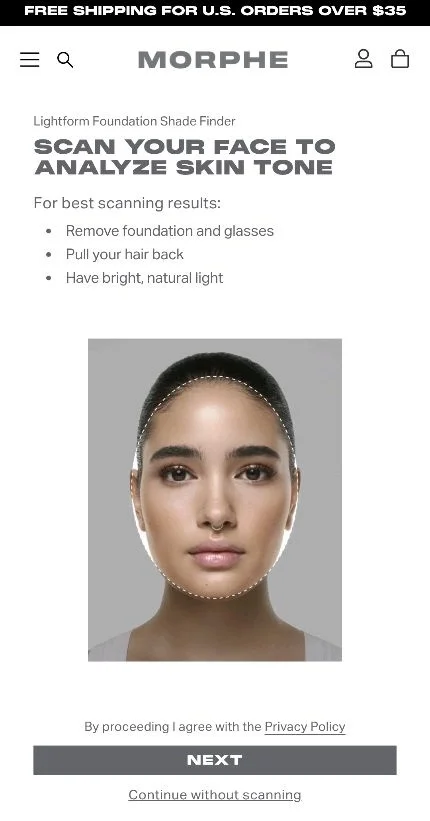
How you can apply this gamification idea on your eCommerce store:
We’ve already seen quizzes in lead captures, guided selling – this one is all about building confidence in the purchasing process.
Research shows that when people enjoy the buying process, they feel more certain about what they bought. Uniqlo puts this into practice with their ‘MySize Assist’ size recommendation quiz. Note how the rich images show the fit:
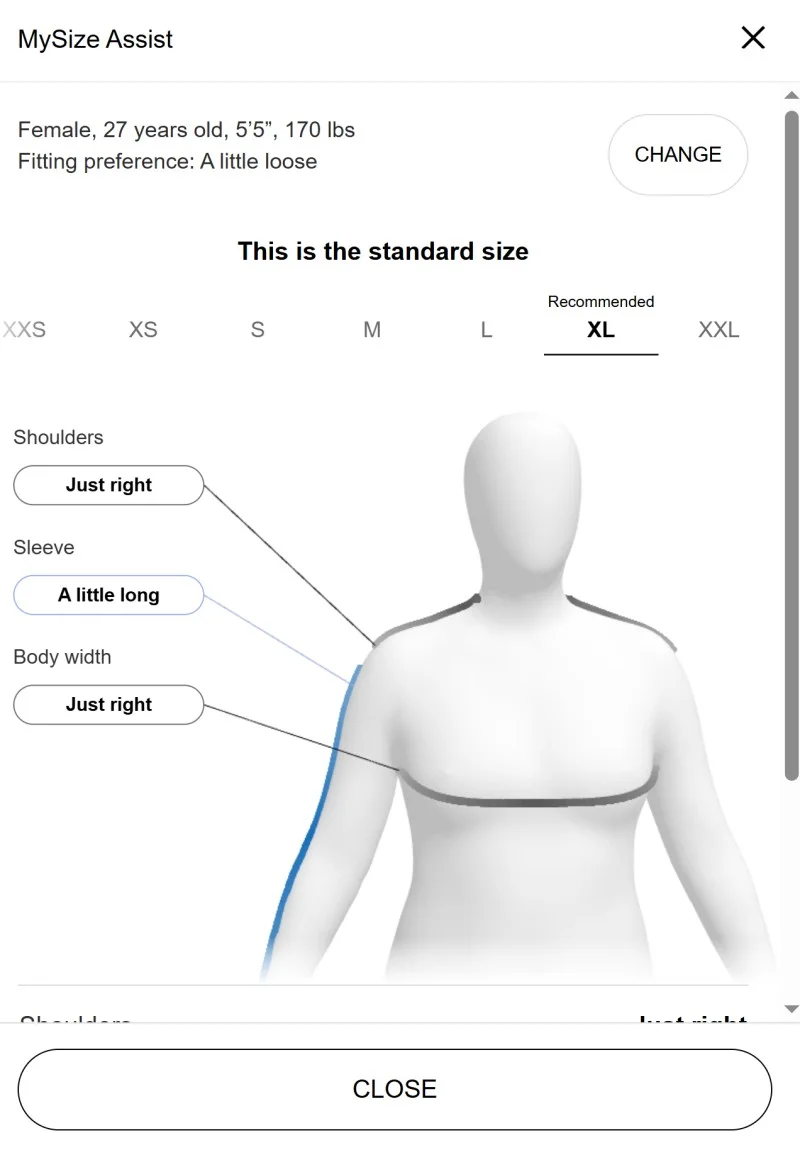
What to remember before applying this gamification idea:
Also read: 30 Ways to Build Trust FAST (On Your eCommerce Store)
This gamification example is actually a bit hard to achieve, but still doable, if you’ve an AI-powered chatbot trained on your product catalog.
Selkirk’s Paddle Assistant is like ChatGPT, but for pickleball – all users have to do is pick from choices, and that’s about it:
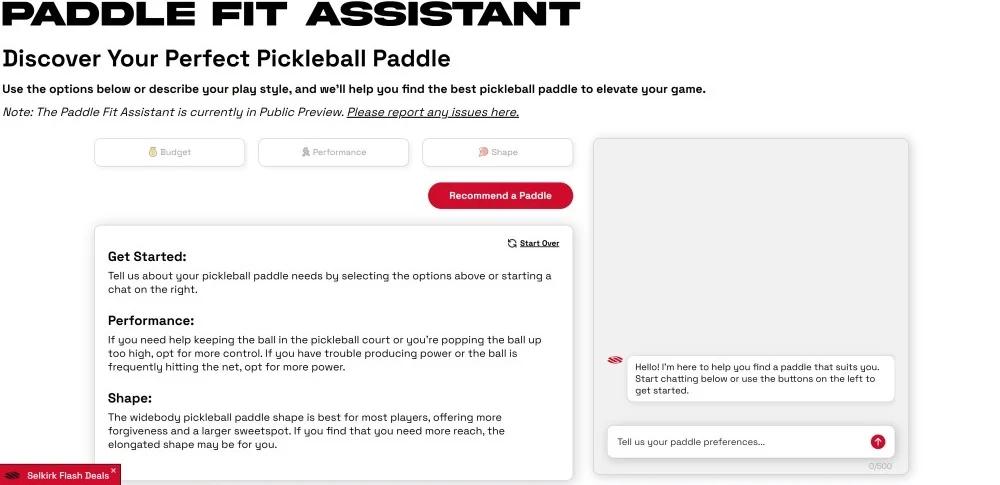
What to remember before applying this gamification idea:
Also read: Using AI to Improve eCommerce Product Discovery: 9 Neat Ideas
This gamification example from Lalo proves how gamification can not only help deepen the relationship between shoppers and your brand but also drive retention.
This email from Lalo is one from their campaigns (one where they ask shoppers to submit their own designs). In this one, they ask shoppers to vote on these designs.
The incentive for voters? A chance to win a $500 gift card. For participants? A chance to become a Lalo Product, free merch, sales percentages, and a matching donation. What this does is: it not only deepens the connection between the community, but also creates an unspoken investment in the product (which’ll ensure future sales):

What to remember before applying this gamification idea:
Also read: 19 Customer Retention Strategies that Actually Work (for eCommerce)
When you lock a solid deal behind a ‘feel-good’ factor like a donation, you may just end up creating a ‘cult’ like gamification, like Cult Beauty does.
Puns apart, this is exactly how you can tie cause marketing to gamification. What Cult Beauty does is set a minimum donation of 5 Euros to unlock a flat 20% off a shopper’s next order:

What to remember before applying this gamification idea:
Also read: How To Increase eCommerce Sales: 35 Proven Ideas
If you run subscriptions, this is THE gamification example to get inspired from. This also applies if you’ve non-converting shoppers who’ve been visiting your site multiple times, but just aren’t buying.
Last Crumb offers their shoppers the option to order just to their liking. They can choose from two sizes, subscription intervals (or one-time delivery), and create just about any combination of cookies (this helps create a trial-like experience):
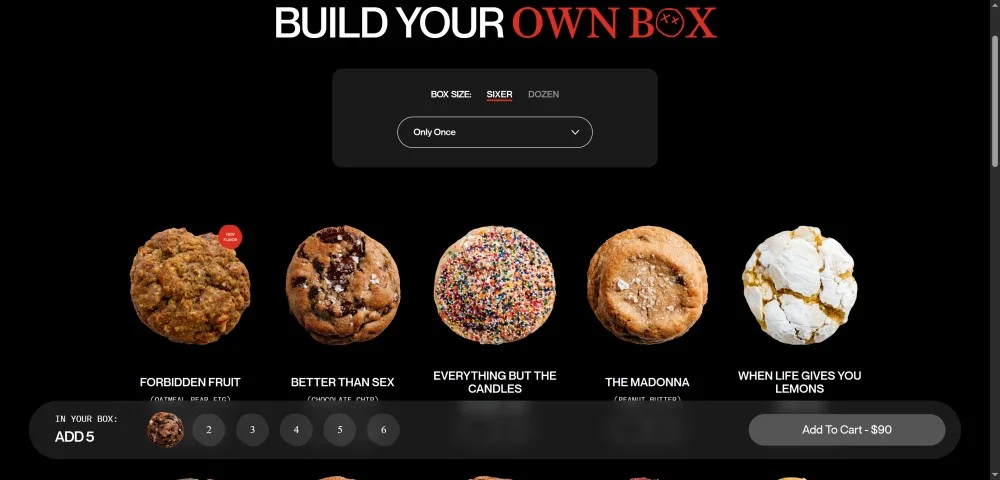
What to remember before applying this gamification idea:
Also read: 15 Product Bundling Examples That Convert (& 9 Proven Ideas)
Most eCommerce brands run loyalty programs, but none as good as e.l.f.
The reason: they gamify their entire loyalty program – here’s what they do:

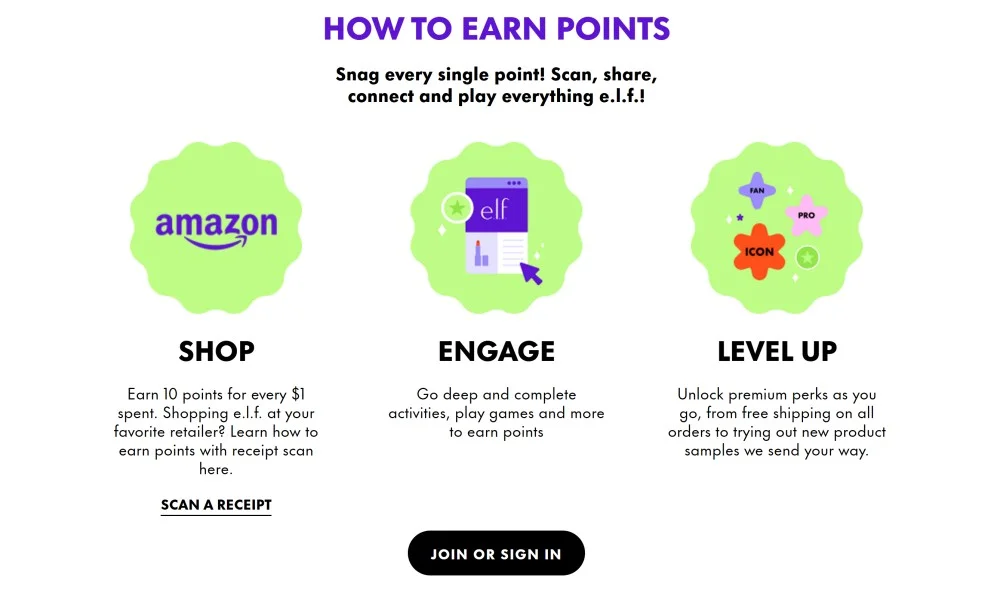
What to remember before applying this gamification idea:
Also read: 14 eCommerce Loyalty Programs Backed By Science (Examples)
What if there were a way you could ensure shoppers use your products the way you intended them to be used?
Take a cue from how Nuun Hydration ensures its post-purchase experience involves a form of gamification, which would ensure loyal shoppers keep repurchasing.
All they do: offer points for every Strava registration, and for every activity and workout logged on the app 💡:
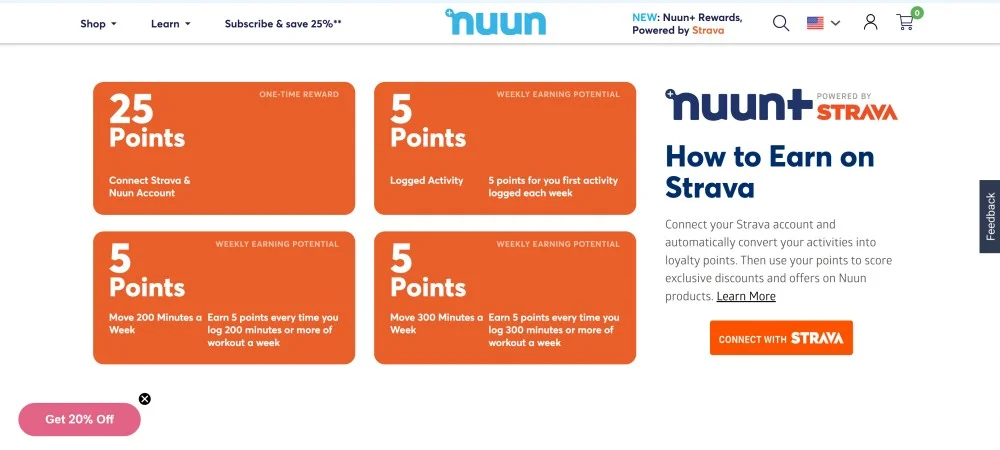
How you can apply this gamification idea on your eCommerce store:
Also read: Deliver An Amazing Post Purchase Experience: 17 Ideas (& Examples)
The OG eCommerce gamification technique. Shoppers spin a roulette wheel, they win (usually a discount or free gift), and you get their email or number in return.
It works best as an exit-intent pop-up, like GNC does, when shoppers ignore the welcome offer and start to leave:
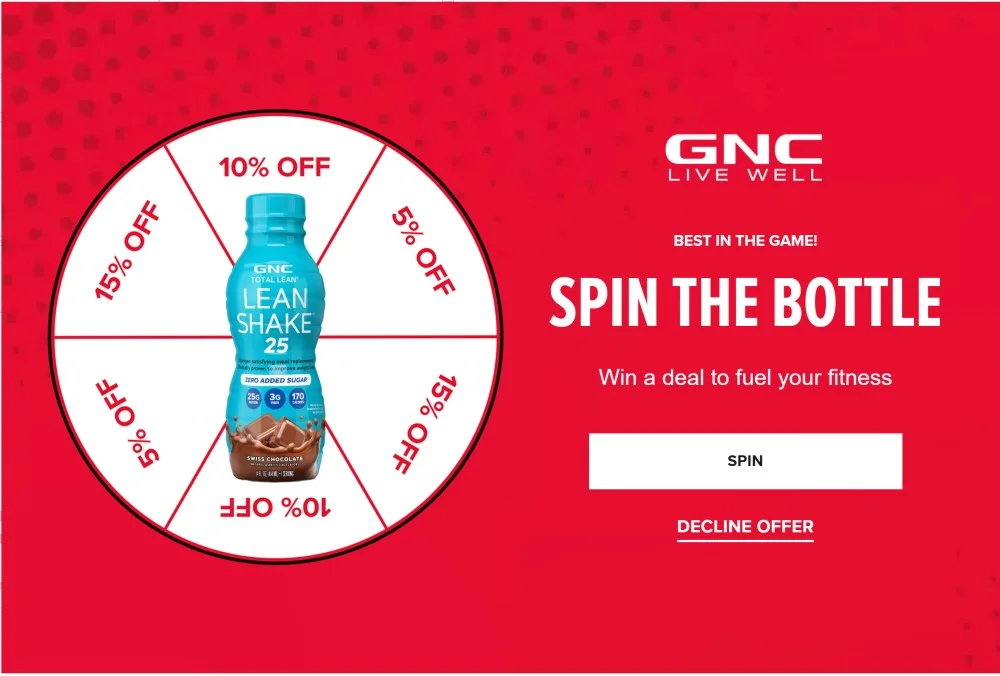
What to remember before applying this gamification idea:
P.S. Scratch cards and casino-style roller pop-ups have almost the same effect as this gamification example.
Progress bars work because our brains hate unfinished tasks.
When shoppers see they’re $7 away from free shipping or a free product, they’re far more likely to toss in that extra candle or keychain (which helps increase the AOV).
Here’s how REP Fitness does it: they float a bar on the cart page, with multiple tiers. A 10% discount is the final milestone, but free products are easier to unlock early:
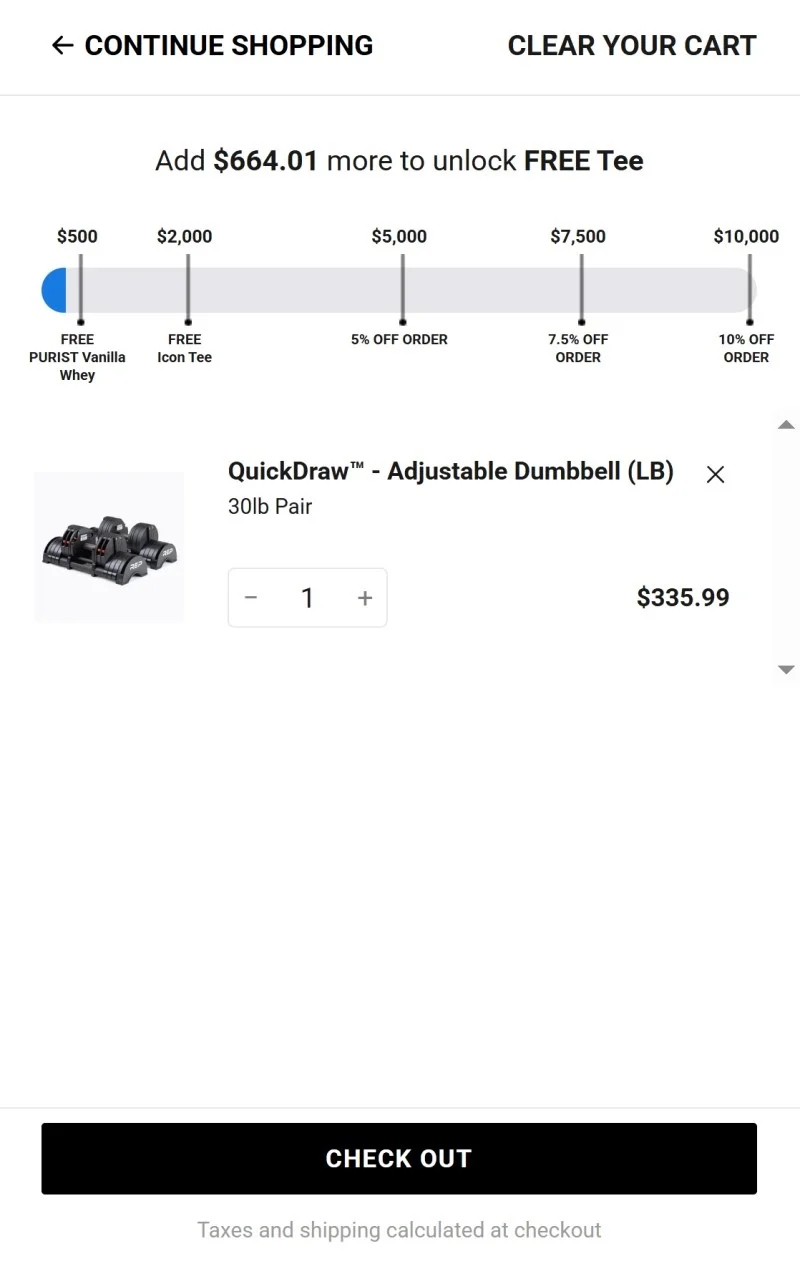
What to remember before applying this gamification idea:
Also read: Top 29 Cart Page Designs For 2025 (Examples)
Adding a little friction helps. Especially when it helps improve the shopping experience (plus, the discount, of course).
Here’s how Retrospec gamifies their pop-up: they ask for a shopper’s preference for other offers that they might be interested in.
This makes the lead capture feel more like a quiz than a form:
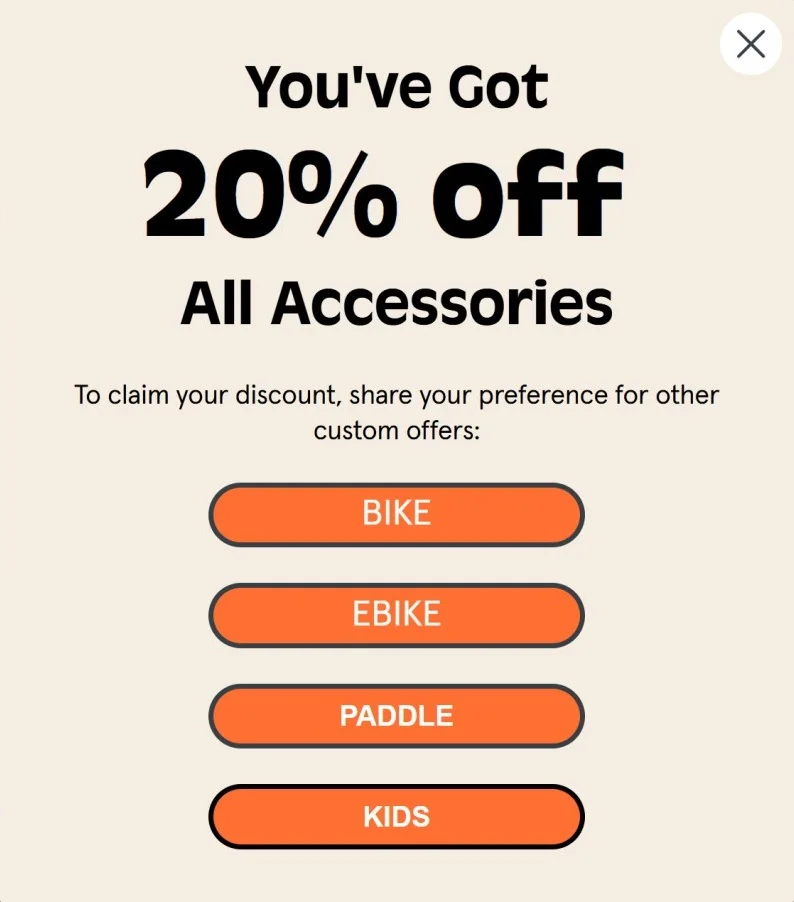
What to remember before applying this gamification idea:
Also read: Cart Abandonment Pop-Up: 19 Amazing Examples (That Actually Work)
If people are dropping off your product pages or not moving from your homepage to the product page, this is the gamification technique to use.
Gibbon USA preloads a comparison table on its product page, along with a ‘1-minute quiz’ to help shoppers figure out which board will be right for them. Note how they mention the time limit to not only help lower the cognitive load but also make it feel low investment:
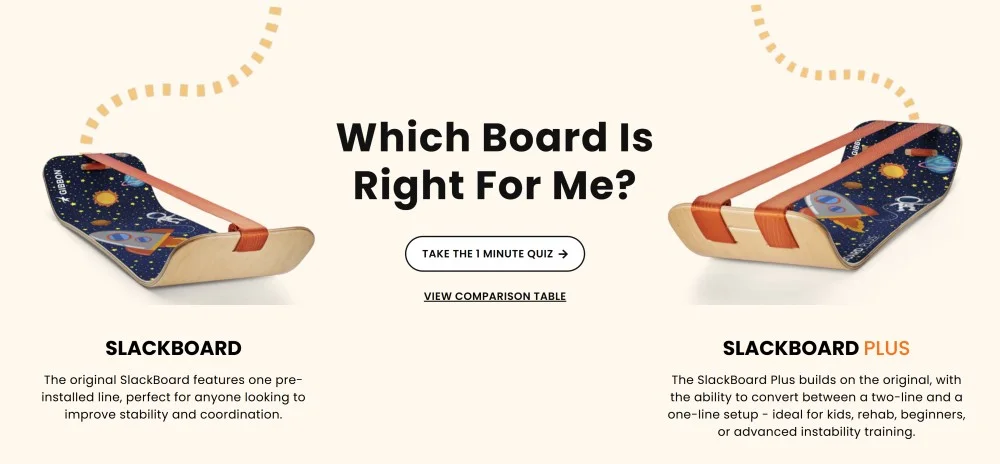
What to remember before applying this gamification idea:
💡 Convertcart Pro Tip
You can create a swipe ‘yay’ or ‘nay’ (like Tinder) to gamify product discovery quizzes. You can apply this same principle to swipeable product cards in category pages.
We already know our brains hate not knowing stuff. The same principle can be applied when shoppers see images with hotspots, which they click on to reveal product features.
This is exactly what Nomadix does to show product features on a tappable image. This keeps it interactive, quick, and way more memorable than a long block of text:

What to remember before applying this gamification idea:
Also read: 37 Insanely Creative Ways eCommerce Brands Use Images
Everyone loves a surprise, especially when it’s free.
This is exactly why Oru Kayak’s automatically added free gift creates the perfect gamification – all a shopper has to do is open the product page (which makes it feel like the discovery of a lifetime):
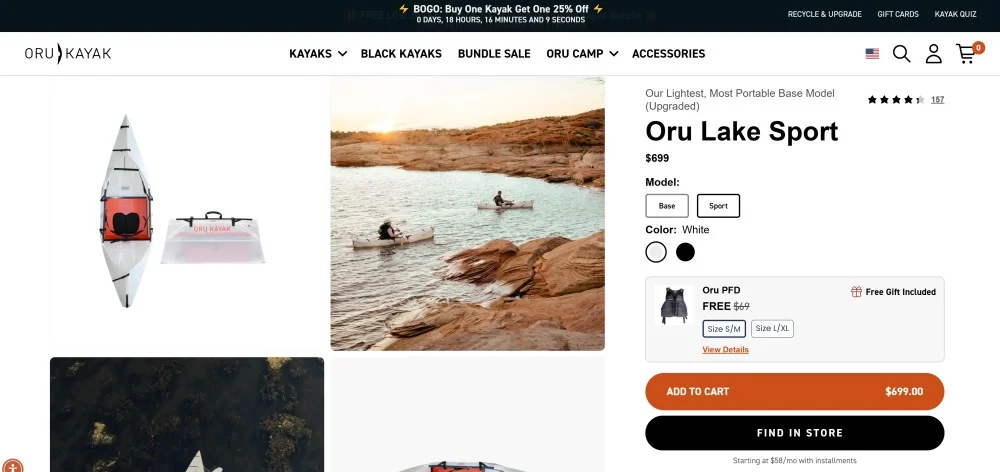
What to remember before applying this gamification idea:
Also read: 30 underutilized strategies for increasing customer lifetime value in eCommerce
This gamification technique is especially useful if you’re trying to drive daily visits (and build a habit).
Just like Lowe’s does – by creating a ‘deals of the day’ page and putting select categories and product ranges on deep discounts (which not only helps clear out stock but also creates urgency-driven curiosity):
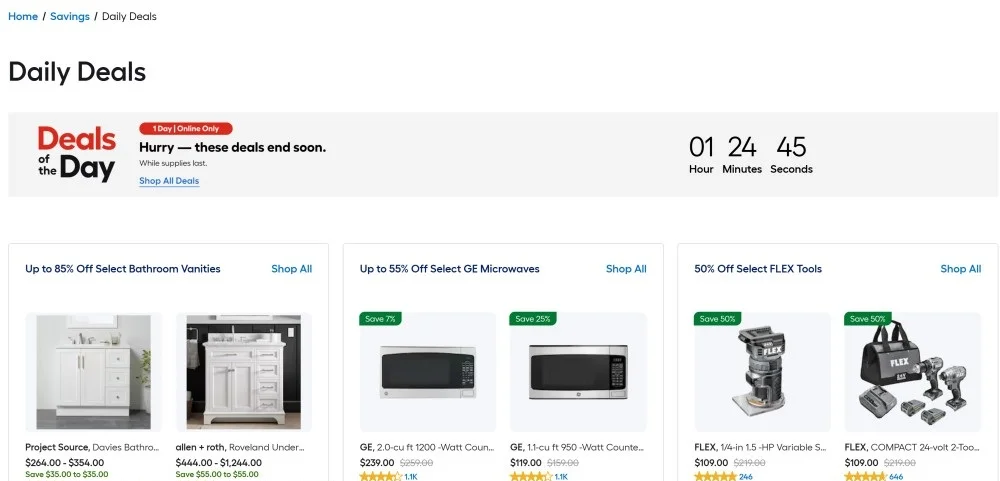
How you can apply this gamification idea on your eCommerce store:
Also read: 20 Powerful FOMO Marketing Ideas for eCommerce
What if you could combine progress bar gamification with the surprise free gift technique?
This is exactly what Dr. Barbara Sturm does on their order summary page, by asking users to select a complimentary gift when shoppers have reached an order value threshold:
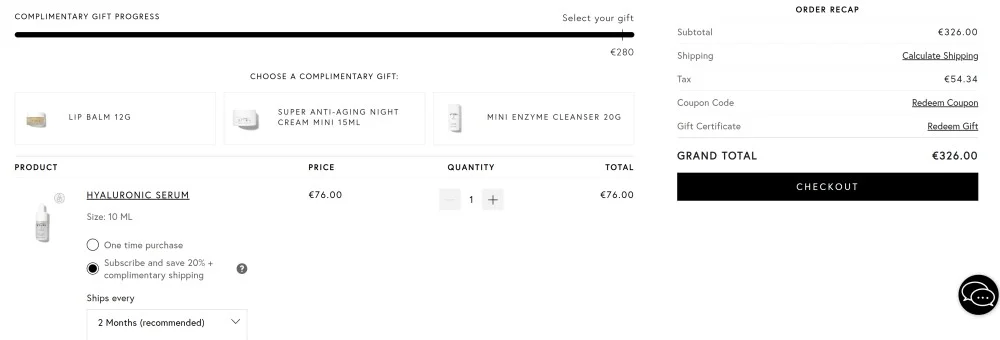
How you can apply this gamification idea on your eCommerce store:
Also read: 35 Stunning Examples of Checkout Pages
If spin-to-win gamification seems too hard to achieve, this is the easiest (yet extremely effective) bypass.
All you have to do is tease exclusivity, like Ergatta does in this exit intent pop-up, by offering shoppers their own ‘secret offer’:
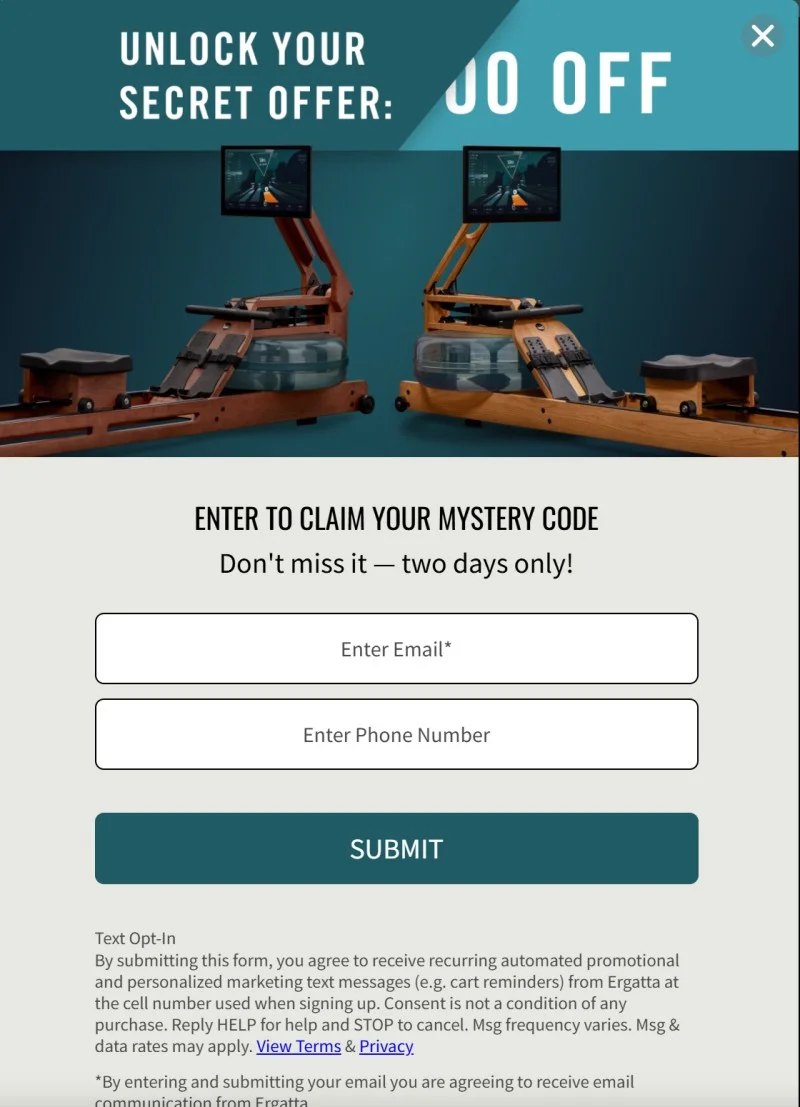
How you can apply this gamification idea on your eCommerce store:
Or you can make it even simpler: make choosing variants feel like a game.
This is exactly what Burrow does. While their modular furniture itself feels like a game, note how each product variant configuration looks like a schematic in a game, which unlocks a product only when shoppers click on ‘em (the FAQs are the cherry on top):
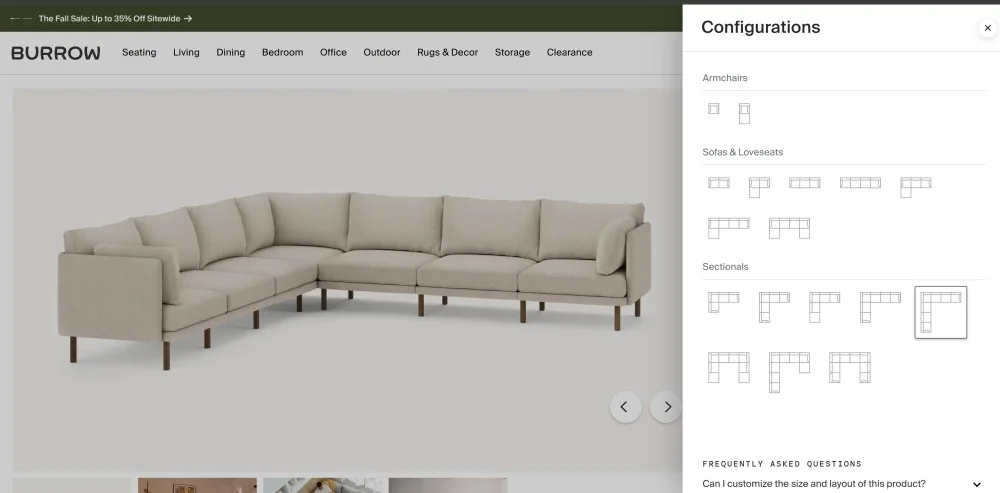
What to remember before applying this gamification idea:
The easiest example of gamification: get shoppers to engage with your posts.
Take this simple Instagram post from Quaker Chewy – note how they ask their followers to look at a certain area in the image, and then ultimately lead to a part of the creative, where they announce their ‘secret’ Halloween giveaway:
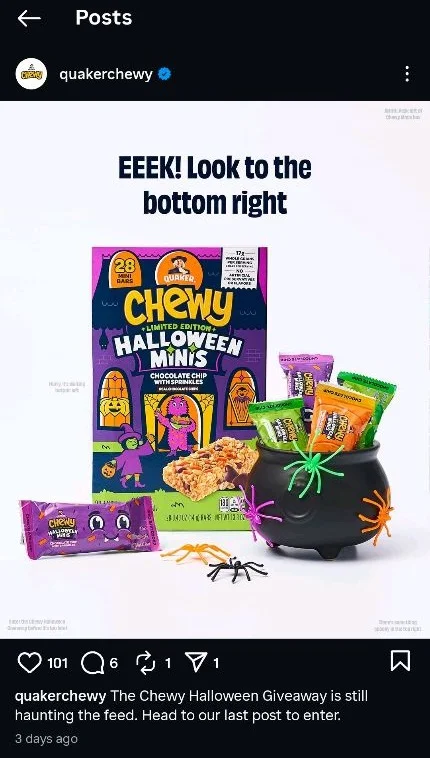
How you can apply this gamification idea on your eCommerce store:
Quizzes as a gamification element in eCommerce stores aren’t just about creating segments; they’re also about creating a guided selling experience.
Hers for Women’s Health nails this by turning quizzes into a full-onboarding experience. Shoppers answer a few questions, get personalized recommendations, and build a profile they’ll keep coming back to:
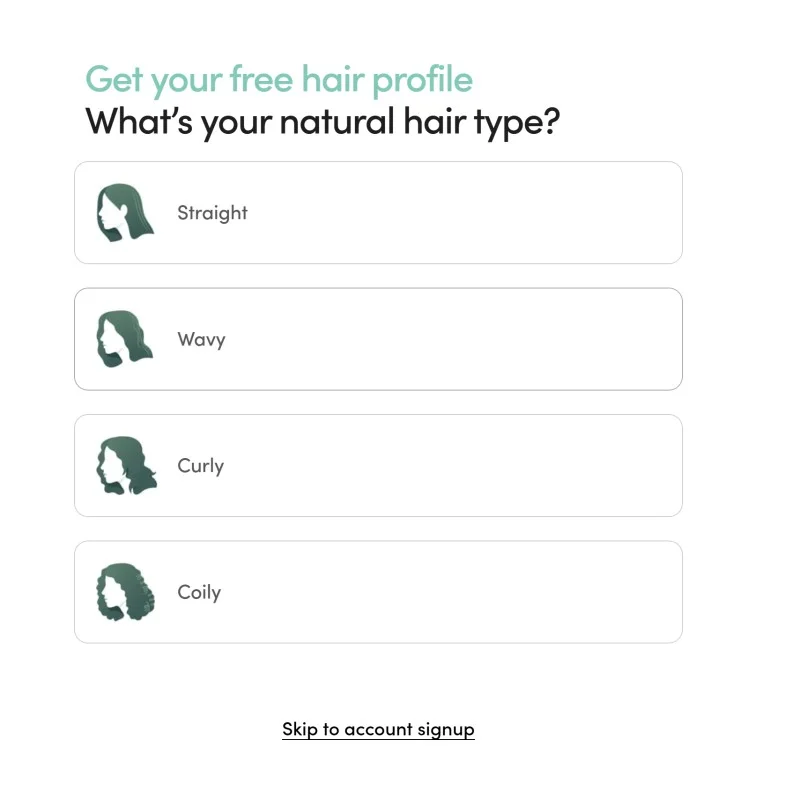
How you can apply this gamification idea on your eCommerce store:
Also read: The Best Quiz Funnel Examples for your eCommerce Store
This is yet another really simple gamification example: all you have to do is just ensure your copy game is strong enough to make shoppers scroll.
To show you how effective this email gamification strategy is, we aren’t gonna tell you how Canvaspop gamifies their email. You have to scroll to find out 🙂

What to remember before applying this gamification idea:
Also read: 15 Top Examples of eCommerce Teaser Emails (+ Templates)
The exclusivity of a livestream is enough to bring it into the list of gamification examples in eCommerce.
Extremely simple to set up, you can use livestreams to drop limited edition products and even create giveaways. This is exactly what Crocs does by teasing that if their livestream gets 10 more orders, they will drop an exclusive discount code for livestream viewers:
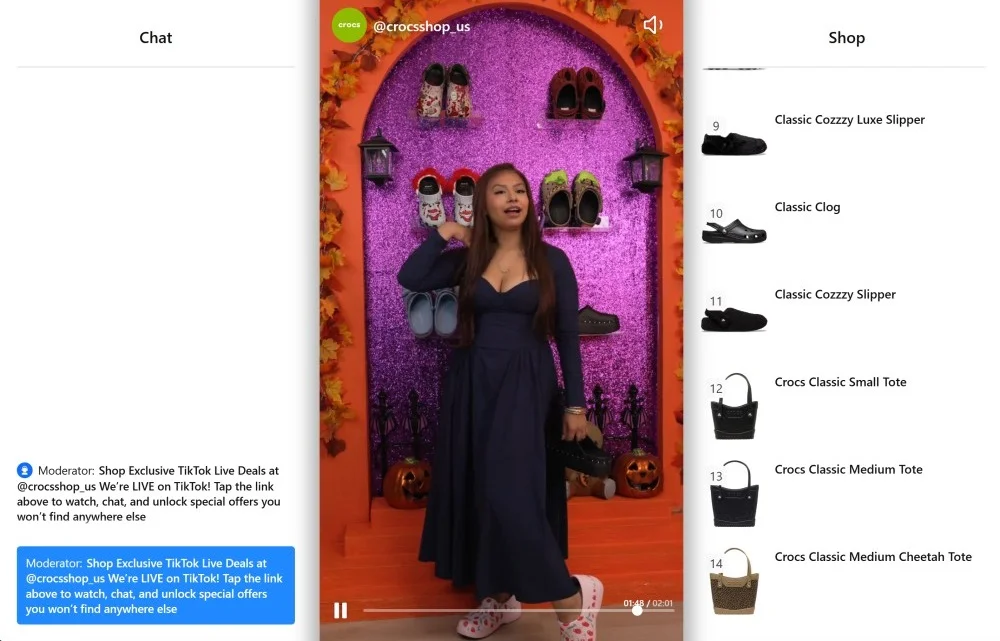
How you can apply this gamification idea on your eCommerce store:
Giveaways are games themselves, but they don’t have to be extremely complicated.
You can create a simple 3-month-long lottery system, like Pure Life does, to offer three different tiers of prizes, with the ultimate Grand Prize being a trip to Disneyland, with round-trip airfare, $1000 in gift cards, and more:
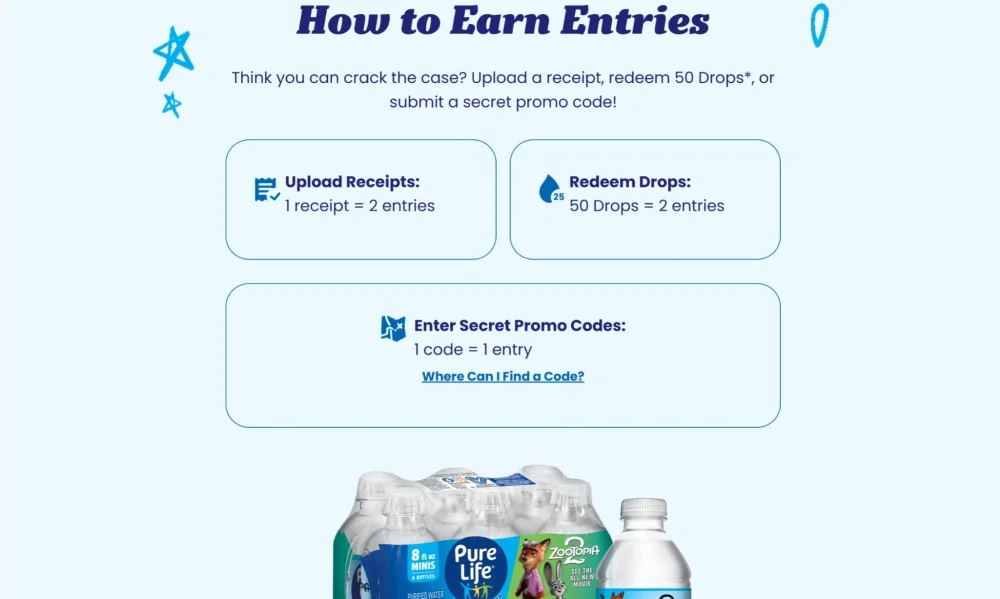
What to remember before applying this gamification idea:
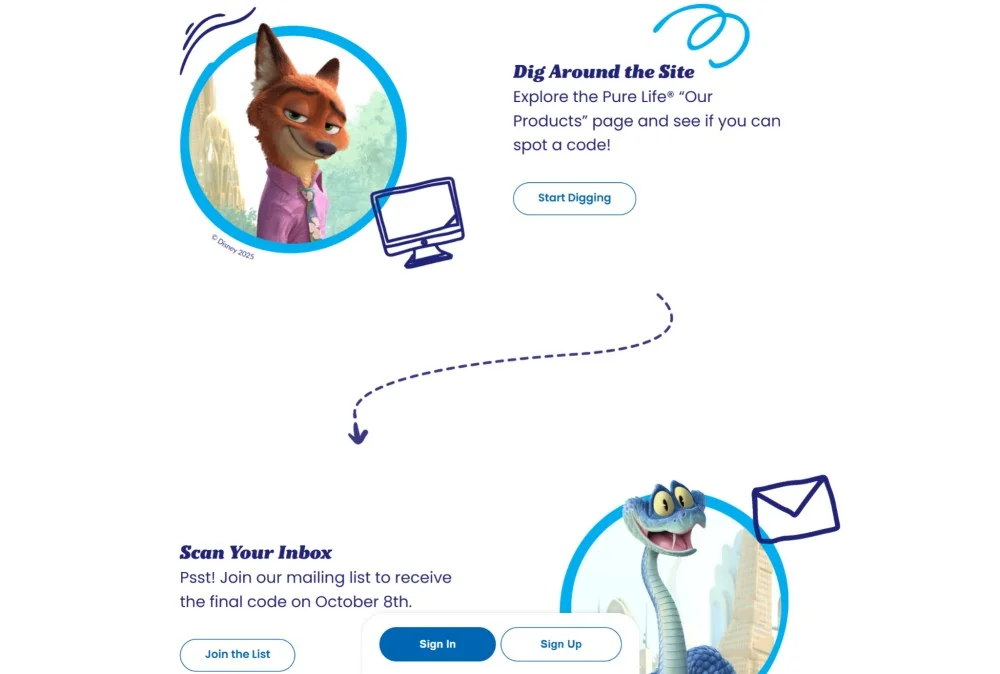
We couldn’t resist using this gamification example. After all, it’s a ‘golden ticket’ on offer.
We are Knitters, pick orders at random to deliver a mystery offer and a ‘golden ticket’, and encourage shoppers to place an order, so they can win too:

How you can apply this gamification idea on your eCommerce store:
Got a segment of purchasers who just aren’t leaving a review?
Use this gamification example from La Jolie Muse as inspiration. Note how they offer a guaranteed gift card of $10, and a chance to win a year of fragrance as first place:

What to remember before applying this gamification idea:
The teaser email in one of our earlier emails is enough proof that your eCommerce emails can be gamified as well.
While some emails can show dynamic content, like an update on reward points, you can take it up a notch, like Ulta Beauty does.
What they do: offer select upgrades (for active shoppers who haven't been purchasing as much or stopped altogether) + some dynamic recommendations on what to do with the points earned:

How can you apply this gamification idea:
Also read: 11 High-Converting Win Back Email Examples (+ Templates)
This gamification example from Astrid & Miyu shows how exactly you can create holiday-themed gaming experiences on your eCommerce site.
What they do is tease their Advent Calendar-themed jewelry for early access to their email subscribers (making it feel like an achievement):

How you can apply this gamification idea on your eCommerce store:
Also read: The Most Creative Black Friday Campaigns - in eCommerce
Give $X to get $X is something most shoppers see, but don’t act on 🙁
But, you can take a book out of Five CBD’s page and offer gifts (a more direct reward) when shoppers refer. Note how they place their gummies in the image to create a hint of what shoppers will actually receive:

What to remember before applying this gamification idea:
Also read: eCommerce Referral Marketing Cheat Codes: Hacks from 6 Amazing Programs
This gamification example from Coogi Australia combines loyalty points with the exclusivity of a limited edition collab collection.
By offering an assured reward of 100 loyalty points (equivalent to $5), Coogi Australia asks shoppers who’ve purchased the collection to take a chance to win 2000 points (or $100):

Start simple. You don’t need to invest immediately in a gamification tool. What you need is a clear goal.
Figure out what’s broken first: are people bouncing early, not signing up, or not buying again?
Then pick the right trigger, like rewards for engagement, progress bars for motivation, or challenges for retention.
Then pick tools that are already built for your CMS platform (like quiz builder plugins, etc.)
Run small 15-day A/B tests and measure whether there’s a lift in signups, repeat visits, or AOV.
P.S. If you run actual games, like spin the wheel, or ‘try your luck’, don’t always let shoppers win. A “You won!” every time makes it all the less fun.
Small stores don’t need AR or custom mini-games. You need quick dopamine hits that make people come back.
These are cheap to set up and easy to A/B test, yet create a big lift in engagement and repeat sales.
Pretty much, but only if it fits how your shoppers already behave.
If you sell everyday items, gamify convenience (progress bars, daily rewards, streaks).
If you sell premium or high-consideration products, gamify discovery (quizzes, build-your-own tools, exclusive drops).
And if your audience skews older or more practical, keep the design subtle. Focus on progress and payoff, not over-the-top designs.
A simple change in how you frame your copy can create gamification.